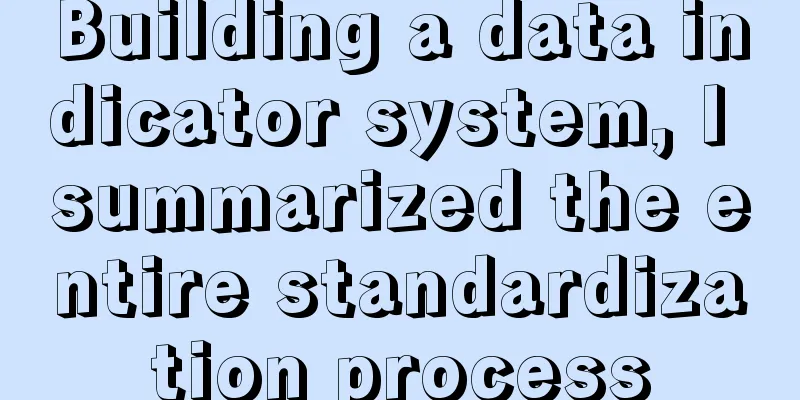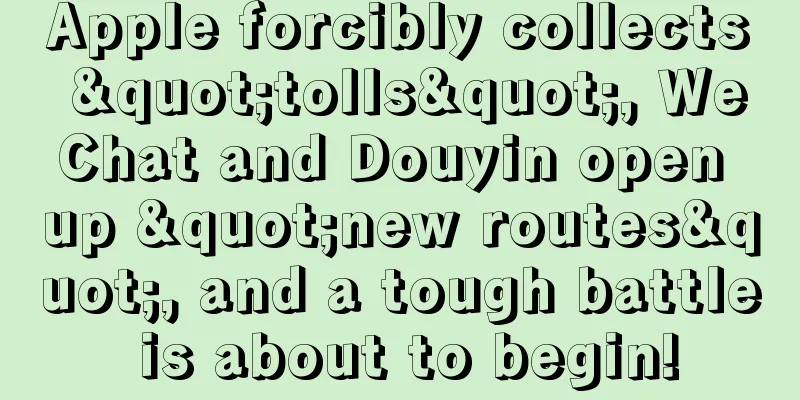Building a data indicator system, I summarized the entire standardization process

When it comes to the indicator system, many students blurt out "AARRR", "OSM", "UJM" like a crosstalk... They are so happy to talk about it, but the interviewer will refute it with one sentence: "This is the indicator system of sales operations!" "Explain clearly what O is O and how U is U!" Many students will be at a loss. Today, I will systematically explain how to deal with such problems. Like many data analysis problems, there is nothing wrong with OSM and other theories. The problem is that we cannot treat theories as dogma. If we don’t go deep into the business process and consider specific scenarios, we will not be able to build a useful indicator system. Step 1: Clear business scenarioThe so-called business scenario refers to what business the data indicators are supposed to reflect. It includes four aspects: 1. What are the business objectives? 2. What is the business process? 3. What actions does the business side take to influence the results? 4. Business process/business process, what data are recorded? Many students do not know how to sort out indicators when facing specific business, which is essentially because they are not familiar with the business. Even if they do not ask about the "sales operation indicator system", but ask: “What do salespeople sell?” “Who are the target customers?” “How do salespeople sell it?” “What does sales operations operate?” If you can’t answer any of them, how can you sort out the indicators? Understanding the business is the first requirement. After understanding the business scenarios, you can start sorting out the indicators step by step. Step 2: Clarify business goalsBusiness goals are what the business cares about most, and they also determine what the main indicators of the indicator system are. When collecting data, we must prioritize the collection of the main indicators; when developing the indicator system, we must also prioritize the display of the generation process of the main indicators. In the minds of the business side, the business goals are very clear, so they can be communicated directly. For example, in sales operations, common main indicators include: 1. Sales target achieved → indicator: sales revenue (amount) 2. Sales performance increase → indicator: sales revenue growth rate 3. Sales team stability → Indicator: Overall turnover rate/A-level turnover rate 4. Number of specific customers developed → Indicator: Overall turnover rate / A-level turnover rate … After sorting these out and setting the main indicators, we can then combine them with specific business processes to see how the main indicators are achieved. Step 3: Sorting out business processesBusiness process is the main data source, and the primary task of the indicator system is to provide feedback on the business process. After the main indicator is obtained, the process indicator should be combined with the business process. Only with the process indicator can we explain why the main indicator is low or high. Let’s take sales operations as an example. The work of sales operations is superimposed on the normal work of sales, so there are two business processes to sort out: 1. Sales operation process 2. What optimizations have been made in sales operations? Different sales processes have different operations. If you want to make the indicator system specific and implementable, you have to delve into the business details to see how it is actually operated. Some processes may be very simple, such as sales with their own customer resources, so they can contact the customer themselves → sign the contract, and that's it. But some processes may be very long, such as selling software, from receiving customer leads to closing a deal, there are many steps, and you can't be lazy here, you have to sort it out step by step, and it's best to draw a flow chart. (As shown below) Sales operations can be roughly divided into three parts: 1. Training: training sales staff on product knowledge, sales techniques and skills 2. Incentives: material incentives, spiritual incentives 3. Organization: SOP formulation, process management You can't be lazy here, you need to understand the details. For example, for training, what time, what topic, how many people will participate, you need to know it in full. For example, for incentives, the reward rules for material rewards, you need to understand the details (as shown below). These details are the direct driving force for sales to do things. There is a common misunderstanding here, that is, when sorting out the indicator system, many students only focus on user behavior and not business actions. For example, when sorting out sales indicators, it is simply: sales = number of salesmen * transaction ratio * average transaction amount, and that’s it. As for what kind of reward and punishment measures there are, and what kind of regulatory systems there are, I have no idea. This will result in the indicator system only showing the results, not explaining the reasons, and there is no way to compare and analyze. In the end, I was scratching my head at the three indicators of number of people, proportion, and per capita amount: Why did it go up? Why did it go down? (As shown below) Step 4: Confirm data collectionData records are a guarantee. If the business process is not highly digitized and there is no data record, then nothing can be done. For example, if you want to interpret sales performance, you have to understand the sales process and know what the salesperson did and did not do. If you want to diagnose sales ability, you have to understand the salesperson’s personal portrait and know what experience and background the salesperson has. If you want to analyze the effectiveness of operational actions, you have to record the time when each action was launched and on which people it affected. If none of the above is available, and there is only a completed order and the salesperson's personal number on the order, then there is really nothing to analyze. The final data is only: Sales = Number of salespeople * Transaction ratio * Average transaction amount per person Based on such a small amount of data, we can do some simple and rough analysis, such as: 1. Rank the salespersons, analyze their performance stability, and identify the best salespeople 2. Rank teams and analyze team management levels 3. Compare the differences before and after the activity/policy is launched, and roughly observe the effect Of course, due to the lack of details, these analyses are easily questioned. Without data, there is no point in analysis! This point must be firmly kept in mind. In various occasions, striving to promote the digitalization process and striving to increase the business department's attention to the collected data (rather than increasing the business department's expectations for the results of data analysis) is the magic weapon for data analysts to save themselves. As for those who keep boasting: "I have an invincible general algorithm, and once the code runs, I know everything about the world and the air in between", you should draw a clear line with him and let him face the doubts of sales alone. After failing a few times, he will know to make changes. More scenesNot only sales operations, but any data that wants to be implemented in specific business must go through this process. For example, in the commodity management scenario, you must first know: 1. What type of product is it, what is its shelf life, storage requirements, and logistics requirements? 2. What is the process of product selection, pricing, warehousing, shipping, and listing? 3. What is the plan of the merchandise management department to change prices, conduct promotions, and make displays? For example, in the content operation scenario, you must first know: 1. What type of content is it, video, text, poster? 2. What is the content creation process from goals, topic selection, materials, to publishing? 3. What is the content operations team’s operational plan for different content themes? |
<<: Regarding the operation of Xiaohongshu, how to do a good job in account creation
>>: Xiaohongshu 2025 trend forecast + cutting-edge strategy sharing
Recommend
How to start a business on Douyin from scratch?
This article shares the principles of the Douyin s...
How to pay for eBay advertising? How to advertise on eBay?
For eBay merchants, they need to do a good job of ...
Beware of the "AI face-changing" scam! You won't be fooled after reading this article!
With the development of AI technology, which makes...
What is the role of cross-border e-commerce product titles? Detailed introduction
The prospect of cross-border e-commerce is very go...
What are the characteristics of cross-border third-party payment platforms? Is it convenient?
Now everyone wants to do cross-border e-commerce, ...
When is Amazon Black Friday? What is the promotion model of Amazon Black Friday?
Black Friday carnival is coming soon, and friends ...
Three pictures to explain content marketing in the World Cup
This article analyzes the specific content marketi...
What are the tips for setting up Amazon coupons? What are the uses of setting up?
The coupons on the Taobao platform correspond to c...
Can I return an item after 90 days of purchase on Amazon? Can I return an item after it has been unpacked?
If you purchase goods on Amazon's cross-border...
Traffic "floods" the auto show
The 2024 Beijing Auto Show officially opened yeste...
What are the requirements of Amazon platform for product main pictures? How to make Amazon main pictures?
In this highly competitive market, the main image ...
A collection of copywriting, there is always one suitable for you
How to write a copy? Let's take a look at the ...
Win the 2023 Christmas season by doubling your orders! | Christmas overseas marketing strategy
Christmas is one of the most anticipated festivals...
How to activate Wish? What are the conditions?
With the rise of cross-border e-commerce, more and...
Amazon Saudi Arabia and the UAE, which one is better? How to choose?
If you want to open a store on Amazon, you must fi...









